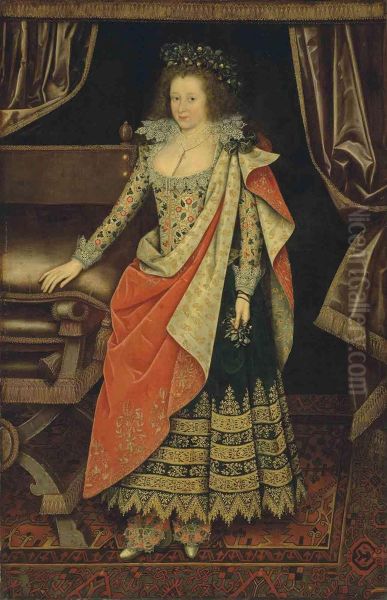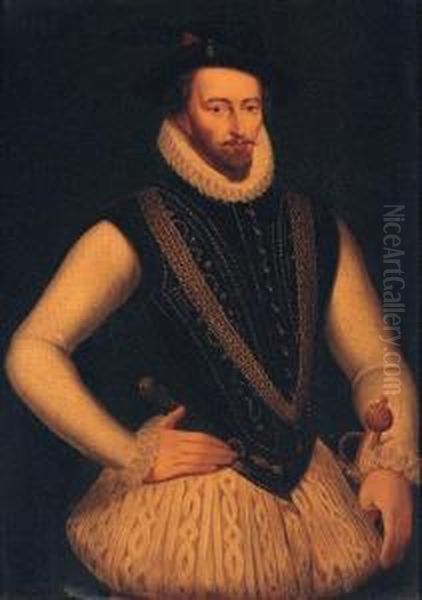Marcus Gheeraerts the Younger (c. 1561/2 – 19 January 1636) stands as a pivotal figure in the history of English art, a Flemish-born painter who rose to become one of the most fashionable portraitists at the Elizabethan and Jacobean courts. His work forms a crucial bridge between the more formal, iconic style of earlier Tudor portraiture and the burgeoning Baroque influences that would later transform British painting. His meticulous detail, particularly in rendering costume and jewellery, combined with a sensitive, if often reserved, portrayal of his sitters, defined an era of aristocratic representation.
Flemish Roots and Early Life in Exile
Born in Bruges around 1561 or 1562, Marcus Gheeraerts the Younger was immersed in an artistic environment from his earliest days. His father, Marcus Gheeraerts the Elder (c. 1520 – c. 1590), was a distinguished painter, printmaker, and designer in Bruges. The Elder was a versatile artist, renowned for his etchings, including a significant series of 108 illustrations for a 1567 edition of Aesop's Fables, titled De warachtighe fabulen der dieren (The True Fables of the Animals), with moralizing verses by Edewaerd de Dene. This book, with its lively and detailed animal studies, showcased the Elder's skill as a draughtsman and etcher.
Another monumental achievement of Marcus Gheeraerts the Elder was his ambitious map of Bruges, completed in 1562. This large-scale work, etched on ten plates, was not merely a cartographic exercise but a proud civic statement, meticulously detailing the city's streets, buildings, and waterways. It was intended, in part, to promote Bruges' commercial importance and navigability. The Elder's artistic training likely came from his own father, Egbert Gerards, and perhaps his stepfather, Simon Pieters, though details of his early formation are scarce. He was also known to have collaborated on projects, such as a "Passion Triptych" with an artist referred to as Van Orley, likely Bernard van Orley or an artist from his circle, indicating his engagement with the rich artistic traditions of the Low Countries.

The religious turmoil of the Reformation profoundly impacted the Gheeraerts family. As Protestants (Calvinists), they faced persecution in the Spanish Netherlands under the Duke of Alba. In 1568, Marcus Gheeraerts the Elder, along with his young son Marcus, fled Bruges and sought refuge in London. This move was part of a larger exodus of skilled Netherlandish artisans and intellectuals who enriched English culture and commerce. The Elder's first wife, Johanna van der Strate (or Struve), the mother of Marcus the Younger, had presumably died by this time or shortly after their arrival. In London, Marcus Gheeraerts the Elder married Susanna de Critz, the sister of the painter John de Critz the Elder, who would later become Serjeant Painter to the English monarchy. This marriage forged a crucial link between two prominent families of émigré artists.
Artistic Development and Emergence in England
Marcus Gheeraerts the Younger would have received his primary artistic training from his father. Living in a household deeply connected to the Netherlandish artistic community in London, he was exposed to a variety of influences. The style of portraiture prevalent in England at the time was dominated by artists like Hans Eworth, another Fleming who had found success in England, and the native tradition of miniaturists such as Nicholas Hilliard. Lucas de Heere, another Flemish exile and a friend of Gheeraerts the Elder, was also active in England during this period and may have contributed to the younger Gheeraerts' artistic environment.
By the late 1580s, Marcus Gheeraerts the Younger was beginning to establish himself as an independent artist. His style, while rooted in the Flemish tradition of detailed realism, evolved to suit the tastes of the English aristocracy. He developed a particular skill for full-length portraits, known as "portraits in large," which allowed for the lavish display of costume and status symbols so important to Elizabethan and Jacobean patrons.
A significant step in his career came with his marriage in 1590 to Magdalena de Critz, the daughter of John de Critz the Elder and thus his stepsister through his father's second marriage. This union further solidified his position within the influential circle of court-connected artists. John de Critz the Elder, and later his son John de Critz the Younger, held the prestigious post of Serjeant Painter, responsible for a wide range of decorative and official artistic work for the Crown.
The Height of Fashion: Portraitist to the Elite

The 1590s marked Gheeraerts the Younger's ascent to prominence. One of his most iconic early works is the "Ditchley Portrait" of Queen Elizabeth I, painted around 1592. This allegorical masterpiece depicts the aging queen standing on a map of England, with stormy skies behind her and fair weather ahead, symbolizing her power and the fortunes of her realm. The portrait was commissioned by Sir Henry Lee of Ditchley, the Queen's Champion, and its grand scale and complex iconography are characteristic of the elaborate visual culture of the late Elizabethan era. Gheeraerts' meticulous rendering of the Queen's pearl-encrusted gown and intricate lace ruff demonstrates his mastery of texture and detail.
Throughout the 1590s and into the early 1600s, Gheeraerts became the portraitist of choice for many leading figures at court. His sitters included Robert Devereux, 2nd Earl of Essex, a favourite of Queen Elizabeth, whom Gheeraerts painted several times. His portrait of Captain Thomas Lee (1594), an Irish cousin of Sir Henry Lee, is particularly striking for its unconventional depiction of the sitter in Irish dress, bare-legged, against a landscape backdrop. This work showcases Gheeraerts' ability to adapt his style to create highly individualized and evocative images.
With the accession of James I in 1603, Gheeraerts's popularity continued. He became a particular favourite of James's queen, Anne of Denmark, painting numerous portraits of her and her children, including Prince Henry and Princess Elizabeth (later Queen of Bohemia). These royal commissions cemented his status as the leading court painter. His portraits of Anne of Denmark often emphasize her regal bearing and sophisticated taste in fashion, with elaborate gowns and jewels rendered with his characteristic precision. Other notable painters active during this period included Robert Peake the Elder, who also enjoyed royal patronage, and the miniaturist Isaac Oliver, who, like Hilliard, excelled in small-scale likenesses.
Gheeraerts's style during his peak years is characterized by a cool, objective observation, a bright palette, and a somewhat linear approach to form. While his figures can sometimes appear stiff or remote, their faces are often subtly characterized, and the sheer opulence of their attire is rendered with dazzling skill. He paid immense attention to the patterns of fabrics, the gleam of pearls, and the intricacies of lace, reflecting the importance of costume as an indicator of wealth and status in Jacobean society.
Contemporaries and the Evolving Artistic Landscape
The artistic scene in England during Gheeraerts's career was dynamic, largely shaped by immigrant artists from the Low Countries. Besides those already mentioned, painters like Paul van Somer arrived in England around 1616, bringing a slightly more sophisticated and psychologically penetrating style that began to offer an alternative to Gheeraerts's established manner. Daniel Mytens, another Netherlandish artist, arrived around 1614 and by the 1620s had largely superseded Gheeraerts as the preferred portraitist of King Charles I (before his coronation). Mytens introduced a greater sense of naturalism and elegance, influenced by painters like Michiel Jansz. van Mierevelt in Delft.
The influence of earlier Flemish masters like Anthonis Mor (Antonio Moro), who had worked for European courts including that of Mary I of England, had set a high standard for court portraiture, emphasizing dignity and realism. Gheeraerts's work can be seen as continuing this tradition, albeit adapted to English tastes. The broader European context also included the flourishing schools of portraiture in the Dutch Republic, with artists like Frans Hals beginning to make their mark with a more dynamic and painterly approach, though this had less direct impact on England until later.
While Gheeraerts the Younger was primarily a portrait painter, his father's diverse output, including map-making and book illustration, highlights the broader range of artistic activities undertaken by Flemish artists of the period. The Elder's map of Bruges, for instance, was a significant undertaking that combined artistic skill with cartographic precision and civic pride. The Elder's Aesop's Fables illustrations, widely disseminated, also contributed to the visual culture of the time. It is important to distinguish these works of Marcus Gheeraerts the Elder from the oeuvre of his son, who specialized more narrowly in portraiture.
The family connections remained important. His brother-in-law, John de Critz the Younger, continued the family tradition as a painter. The artistic community in London, particularly among the émigrés, was tightly knit, with intermarriages and shared patronage networks.
Later Career, Declining Favor, and Legacy
By the late 1610s and into the 1620s, Gheeraerts the Younger's style began to seem somewhat old-fashioned compared to the newer, more fluid and psychologically nuanced approaches of painters like Mytens and, later, Cornelius Johnson (Cornelis Janssens van Ceulen), another successful portraitist of Dutch extraction working in England. While Gheeraerts continued to receive commissions, his dominance at court waned.
The arrival of Anthony van Dyck in England in 1632, at the invitation of Charles I, revolutionized English portraiture. Van Dyck brought an unparalleled elegance, dynamism, and psychological depth to his work, setting a new standard that would influence British painting for generations. By this time, Gheeraerts was an elder statesman of the London art world, his most influential period behind him.
Marcus Gheeraerts the Younger died in London on 19 January 1636 and was buried in the Dutch Church at Austin Friars, a testament to his enduring connection to his Netherlandish heritage. His will mentions his son, also named Marcus (Marcus III), who appears to have been a painter as well, though less distinguished, and another son, Henry. The family details provided in the initial query regarding a first wife Johanna van der Strate and a second wife Suzanna de Caze, with children from both, seem to be a conflation or pertain more accurately to his father, Marcus Gheeraerts the Elder, whose first wife was Johanna and whose second wife was Susanna de Critz (née de Heere, or related to Lucas de Heere's family, and mother of John de Critz). Marcus the Younger's only recorded wife was Magdalena de Critz.
Despite the eventual eclipse of his style, Marcus Gheeraerts the Younger's contribution to English art is significant. For over two decades, he was the pre-eminent face-painter in England, creating a visual record of the Elizabethan and Jacobean elite. His portraits are invaluable historical documents, offering insights into the personalities, fashions, and aspirations of a transformative period in English history. His meticulous technique and his ability to capture the grandeur and formality expected by his patrons ensured his success. He played a crucial role in naturalizing the oil portrait in England, paving the way for the great masters who would follow. His work remains a cornerstone for understanding the visual culture of late Tudor and early Stuart England, a testament to a Flemish talent that flourished on English soil. His influence can be seen in the work of subsequent, if lesser-known, English painters before the full impact of Van Dyck took hold, such as William Larkin and Robert Peake the Younger. His legacy is that of an artist who skillfully navigated the demands of courtly patronage, leaving behind a rich gallery of England's ruling class at a fascinating juncture in its history.